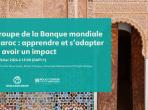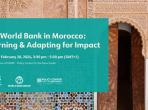Displaying 11 - 20 of 5550

Le Groupe de la Banque mondiale au Maroc : apprendre et s’adapter pour avoir un impact
Cet événement rassemble hauts responsables gouvernementaux, des représentants de la Banque mondiale et autres experts afin de discuter des conclusions d'une évaluation indépendante récemment publiée sur le soutien de la…

The World Bank Group in Morocco: Learning and Adapting for Impact
This event brings together senior government officials, World Bank representatives, and other experts to discuss the findings from a recently published independent evaluation of the World Bank’s support to the Kingdom…

Addressing gender inequalities in countries affected by fragility, conflict, and violence
A recent evaluation by the Independent Evaluation Group (IEG) finds that achieving relevant, deep, impactful, and sustainable change to advance gender equality in fragile environments requires a comprehensive country…

The importance of monitoring and evaluation for World Bank project performance in eight graphs
This is the second of a series of blogs presenting some of the key findings from the 2023 Results and Performance of the World Bank Group (RAP) report, the latest annual review of the World Bank Group’s development…

How can the World Bank help address institutional capacity development needs in Sub-Saharan Africa?
Institutions shape how countries foster poverty reduction, support sustainable growth, and respond during crises. A recent Evaluation Insight Note reviews existing evidence to understand how the World Bank can help…

Evaluating for People and the Planet
The annual report looks back at the past fiscal year and summarizes IEG work, including through first-hand accounts from staff, on the range of validations and evaluations, on informing major World Bank strategies and…

The IDA Private Sector Window: Unlocking private investment in the poorest and most fragile countries
A new evaluation from the Independent Evaluation Group finds that the IDA Private Sector Window (PSW), a development finance tool aimed at catalyzing investments in the poorest and most fragile countries, has passed the…

Navigating challenges: Examining the resilience of World Bank Group projects amid the pandemic
This is the first of a series of blogs presenting some of the key findings and lessons from the 2023 Results and Performance of the World Bank Group (RAP) report, the latest annual review of the World Bank Group’s…

A Focused Assessment of the International Development Association’s Private Sector Window
The private sector is essential for creating jobs and prosperity in poor countries, but developing it is challenging, especially in fragile and conflict-affected situations (FCS).

World Bank Support to Jobs and Labor Market Reform through International Development Association Financing
This evaluation is the first stage of the Independent Evaluation Group’s assessment of the World Bank’s support for more, better, and more inclusive jobs through IDA financing, and it assesses the implementation of IDA-…

